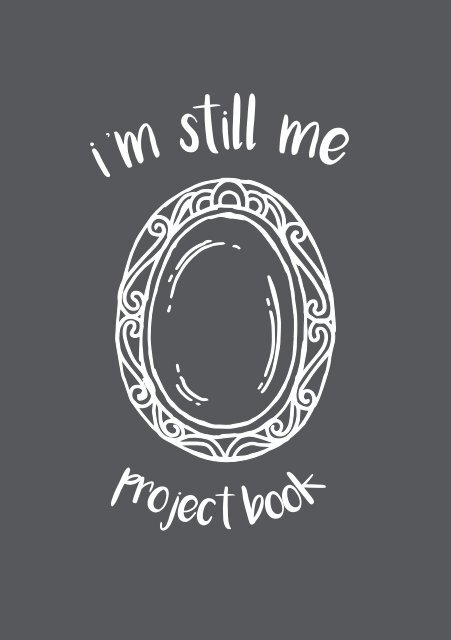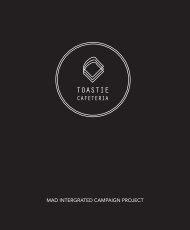project_book_view
You also want an ePaper? Increase the reach of your titles
YUMPU automatically turns print PDFs into web optimized ePapers that Google loves.
i ’m still me<br />
<strong>project</strong> <strong>book</strong><br />
1
2<br />
3
ackground<br />
Singapore is an ageing population with 45,000 diagnosed with dementia<br />
amongst elderly. This figure is <strong>project</strong>ed to increase to 103,000 in 2030.<br />
As dementia grows to be a rising concern, demand for caregiver increases<br />
as well and the need to reach out to these caregivers becomes stronger<br />
as most of them struggles to grasp the concept of caring and living with<br />
a demented patient.<br />
Inspired by personal events, this campaign was created with the aims<br />
to reach out to new caregivers (starting from age as young as 18 to 40<br />
years old). The campaign will have a guide<strong>book</strong> that aims to be a onestop<br />
information source about dementia and caregiving (i.e. it will be a<br />
consolidation of all dementia and care giving related information).<br />
This idea was also inspired by the fact that while there is much<br />
information about dementia, they come in bits and pieces and<br />
tend to just be nothing more than guide brochures.<br />
4<br />
5
the concept<br />
The campaign concept “I’m Still Me” was selected to bring about the message that<br />
dementia does not change the desire for a normal life; demented patients are still<br />
the same person underneath the illness. The morning tai chi routines that they<br />
used to do is still desired to be done by them and the need to care for their loved<br />
ones is still within them.<br />
This concept was formed because of the misconception that a person becomes<br />
different when diagnosed with dementia due to gradual memory loss. For e.g. a<br />
family member might stop the demented patient from attending his/her morning<br />
tai chi sessions for fear that the individual may not be able to remember the route<br />
back home or the family member may asked multiple questions to the patient to<br />
get them to remember.<br />
This is because the people (usually loved ones such as spouses, partners<br />
or siblings) around demented patients are afraid to be forgotten by the<br />
patient. Because of the aforementioned misconception and the fear of being<br />
forgotten one day, a caregiver’s treatments towards the patient may cause<br />
misunderstanding and miscommunication between both parties (patient<br />
and caregiver).<br />
Through the concept of “I’m Still Me”, the campaign’s other aim is to touch on<br />
the struggle that a demented patient goes through as they have difficulty<br />
communicating their inner thoughts and desire, causing frustration and despair<br />
on themselves and the ones around them.<br />
6<br />
7
objective<br />
The campaign aims to clear up misunderstandings and misconceptions of the<br />
illness dementia so that it makes understanding dementia easier for new caregivers<br />
and communicates that while dementia is a deteriorating condition, the illness<br />
is not as bad as how society perceives it to be. New caregivers should feel more<br />
encouraged to be more receptive towards seeking help from professionals such<br />
as the individual organizations instead of trying to solve the issues by themselves<br />
through the exposure of this campaign.<br />
Through the use of visuals and real life scenarios, this campaign hopes to be a form<br />
of emotional support for new caregivers; to let them know that they are not alone<br />
in facing the stress of being a caregiver for demented patients, especially if it is<br />
someone close to them at heart. Moreover, the campaign aims to help the target<br />
audience to realized that dementia does not change who their loved ones are and<br />
they should not be afraid to embrace this new side of their loved ones.<br />
8<br />
9
target audience<br />
- New Caregivers (18-40 years old)<br />
- Education level: minimally O’ level, maximum a degree or higher<br />
- Income ranging $2000 - $5000/year<br />
(middle class)<br />
While the target audience is the general middle-income working class, the<br />
specific target audience is the pool of fast paced working young adults who<br />
wants to know everything via a singular medium. They do not have the time<br />
to do research and piece the information available together as they are going<br />
to be juggling either work/studies together with caregiving duties or all three<br />
responsibilities at the same time.<br />
The specific target audience is also predicted to have short attention spam due to<br />
heavy usage of social media and would generally be more geared to heavy<br />
topics if the topic were presented in an interesting manner.<br />
10<br />
11
design direction<br />
M.C Escher’s Hand with Reflecting Sphere inspired the main design concept of<br />
“I’m Still Me”. This artwork’s main focal point is Escher’s reflection (no matter how<br />
the sphere is rotated) and both reality and reflection is incidentally merged in<br />
this art piece. Riding on this theory, the concept of using a mirror aims to portray<br />
that dementia does not change a person, just like a reflection. No matter if he/<br />
she behaves oddly due to the illness, the reflection (which is also a symbol of the<br />
inner persona) does not change if he/she were to look into a mirror – he/she is still<br />
the same person on the outside and inside. Hence, the design direction focuses<br />
largely on being reflective as it aims to get the target audience to understand<br />
that if you were to wake up one day and be diagnosed with dementia, it does not<br />
change who you’re on the inside and the outside (your reflection).<br />
Different types of mirrors will be used across all items to portray that dementia<br />
does not have a standard form nor a specific TA (aka the elderly) – it can happen<br />
to anyone whenever, wherever. Grey will be the main color scheme because<br />
having the dementia feels like living life in grey scale as both of the patient’s<br />
reality and imagination are being merged (e.g. wanting to have breakfast when<br />
it’s evening as he/she does not have any control of real time vs.¬ reel time in their<br />
mind). Design graphics to be used to represent information will split into two –<br />
1st part which talks about the illness will adapt a vector style while the 2nd part<br />
which talks about caregiving will adapt a water color style.<br />
12<br />
13
deliverables<br />
PUBLICATION – a <strong>book</strong>azine about dementia and caregiving<br />
Book Specification<br />
Size: 240mm x 170mm<br />
Material: 300gsm Art Card [Cover] + 128gsm Matt Woodfree Paper [Inside]<br />
No of pages: 40pp+4pp<br />
Printing: 4C x 4C<br />
Binding: Perfect Bind<br />
Finishing: Matt lamination with Silver Hot Foil Stamping on cover<br />
Website<br />
To share more on the campaign and the <strong>book</strong><br />
Social Media<br />
Face<strong>book</strong> and Instagram Ads<br />
Outdoor Advertising (Bus Stop and MRT Ad)<br />
To promote the <strong>book</strong>/website.<br />
MISC items<br />
Postcards (148mm x 105mm)<br />
14<br />
15
timeline<br />
16<br />
17
sketches<br />
18<br />
19
20







